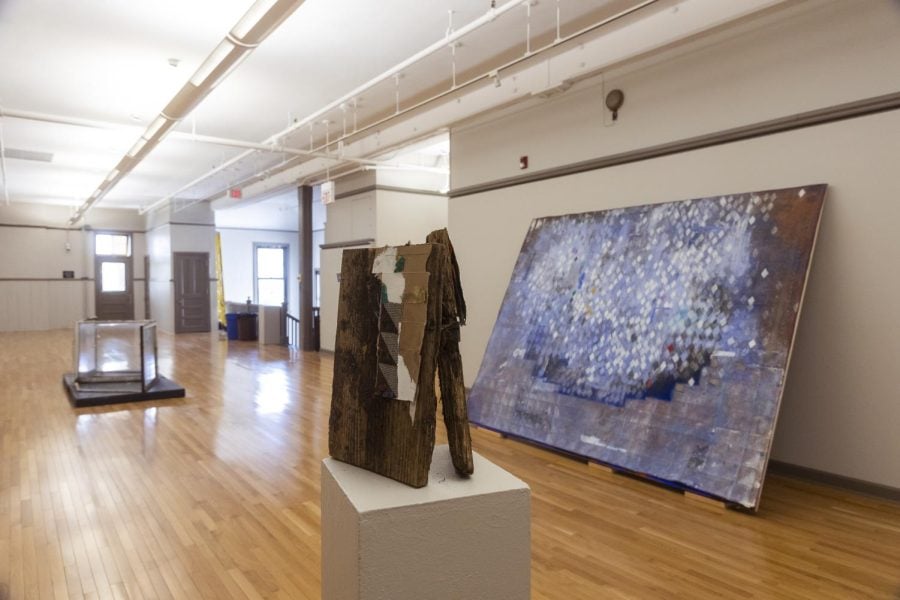New Noyes Cultural Arts Center installation ‘Areito’ explores Caribbean cultural practices and folkloric traditions
Ava Mandoli/The Daily Northwestern
“Areito: Allusions of Sacred Geometry and Diaspora,” an art installation by Miami artist Yanira Collado, will be shown on the second floor of the Noyes Cultural Arts Center from March 25 to May 18. “Areito” creates a visual history of the island of Quisqueya from fragments from Collado’s everyday life.
April 12, 2022
More than 20 years after leaving Evanston, Miami-born and based Yanira Collado is returning and reconnecting with the city.
The artist has returned with “Areito: Allusions of Sacred Geometry and Diaspora,” an installation at the Noyes Cultural Arts Center. Through the display, she said she’s reconnecting with a place she once called home.
“Areito,” which will be shown on the second floor of the center from March 25 to May 18, creates a visual history of the island of Quisqueya, a Taíno word meaning Haiti and the Dominican Republic. The name of the exhibit refers to Taíno celebration chants honoring heroic deeds of Taíno ancestors, chiefs and gods.
Collado’s work stretches across the room, with a 3D wooden installation in the center and canvases across the walls. It features shards of items from her life and the island across a variety of mediums, including wood from an Evanston dumpster, textile samples from clothing she has worn and a triangle of soap made from the sap of a tree native to Quisqueya.
“Much of my work is layered,” Collado said. “First of all, because history is layered. And because The Dominican Republic has a very layered history, and so does Haiti. As an artist, I can choose to sensationalize this or protect it. And I’d rather protect it.”
She said many cultures on Quisqueya contribute to its complex history, including the Arawak nation, Taíno peoples, immigrants and descendants of enslaved people brought to the island, as well as the cultures of the island’s colonizers.
In artwork, layering serves as a form of protection, Collado said. Presenting smaller scraps of art together in relation to each other gives the viewer access to snippets of the island’s history without presenting it as a homogenous product to be sensationalized or misappropriated, she said.
William Cordova, a Peruvian artist, said he first connected with Collado at the School of the Art Institute of Chicago, where they bonded over their Miami roots and the differences their lives took on in Chicago, a city with very different size and demographics than Miami.
Cordova said Collado’s complex layering makes her work stand out from other artists.
“It’s almost as if you’re looking at anthropological research and a map both at once,” Cordova said.
Beyond the island’s history, Callado also addressed her own history and identity as a Black Spanish-speaking woman from the Dominican Republic within the exhibit.
Though she primarily works in Miami, Collado said she wanted to return to Evanston to reconcile with her past. To set up the exhibit, Collado said she relocated to Evanston for a week, where she worked on her installation for thirteen hours a day, beginning at nine each morning.
“I get to come back as a person who has really spent time maturing, growing up and really understanding my identity,” Collado said. “(I’m) presenting that and sharing that and making sure that that’s of service to the people in (Evanston).”
Angela Allyn, Evanston’s community arts program coordinator, housed Collado when she was studying at the Art Institute in the late 1990s. Allyn said she’s hoping to continue to use the second floor of the Noyes gallery for public-facing art that facilitates community dialogue, like the previous “Visible/Invisible” exhibit, which explored visible and invisible forms of violence.
To her, Callado was a perfect match for the space.
Allyn said she hopes Collado’s installation will spark conversations on what history is, what counts as history and how objects can tell it.
“Every single thing you see has a whole story behind it and those stories layer and layer and layer, as human life and meaning layers and layers and layers,” Allyn said. “They’re explicitly beautiful as objects, but they’re also really resonant as sort of the flotsam and jetsam of history.”
Email: [email protected]
Twitter: @yimingfuu
Related Stories:
— Community-centered quilt to become permanent addition to Noyes Cultural Arts Center
— New lives for old buildings: Evanston organizations repurpose empty school buildings
— Evanston artists debut ‘Word’ exhibit honoring black women












